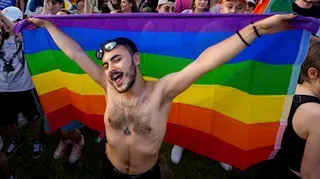December 4, 2013
Study: Non-White, Non-Straight Workers Face Hurdles
Kilian Melloy READ TIME: 4 MIN.
New research shows LGBT workers of color are among the most disadvantaged.
Take a pot and throw in some of the ingredients LGBT people of color face: discrimination coupled with a lack of workplace protections, unequal job benefits and taxation, and unsafe, under-resourced U.S. schools. What do you get? One of the most disadvantaged classes of labor in the American economy.
So says new research from the Movement Advancement Project (MAP), the Center for American Progress (CAP), the Human Rights Coalition (HRC) and the National Black Justice Coalition (NBJC).
The study, "A Broken Bargain for LGBT Workers of Colors," comes on the heels of another recently released and similar study, "A Broken Bargain: Discrimination, Fewer Benefits, and More Taxes for LGBT Workers," which SFGN covered in September.
"Contrary to popular stereotypes, LGBT workers are more racially diverse than the general population, making it critical to address the unique obstacles they face," said Sharon Lettman-Hicks, executive director and CEO of NBJC. "Bias and prejudice based on race, sexual orientation, and gender identity and/or expression intersect to the detriment of LGBT workers of color."
Here are some of the major findings from the study:
1. LGBT People are more racially and ethnically diverse than the U.S. population as a whole:
� About one-third of LGBT people are people of color. In a 2012 Gallup poll, one in three LGBT respondents (33 percent) identified themselves as people of color, compared to 27 percent of non-LGBT respondents (in all, there are an estimated 5.4 million LGBT workers in the United States, of which 1.8 million are people of color).
� LGBT youth of color are at high risk of becoming homeless. An estimated 20 to 40 percent of homeless youth in the U.S. identify as LGBT or believe they may be LGBT. Research also shows that African American and Native American young people are overrepresented among LGBT homeless youth, as well as the broader homeless population. One study found that among homeless youth who identify as gay or lesbian, 44 percent identified as black and 26 percent as Latino.
� LGBT workers of color are at significant risk of being unemployed. They have higher rates of unemployment compared to non-LGBT people of color. In addition, unemployment rates for transgender people of color have reached as high as four times the national unemployment rate.
� LGBT workers of color are at significant risk of poverty. Research shows that they, and particularly black LGBT people, are at a much higher risk of poverty than non-LGBT people.
"Systemic barriers and inequities in the educational system make it harder for LGBT people of color to meet workforce qualifications," said Ineke Mushovic, executive director of MAP. "LGBT workers of color are also unfairly denied or lack access to job-related benefits that other workers take for granted, making it harder for these workers to earn a living and provide for their families."
2. LGBT workers of colors confront a dual burden of social stigma and discrimination.
A few specific obstacles the research found:
� Educational Barriers: LGBT youth of color are among the children who are most at risk of dropping through the cracks of the U.S. educational system. Hiring Bias and On-the-Job Discrimination: Barriers such as unwarranted background checks, inadequate or non-existent non-discrimination protection for LGBT workers, and the lack of mentorships and on-the-job support make it difficult for many LGBT workers of color to find good and steady jobs.
� Unequal Pay, Benefits and Taxation: LGBT workers of color receive unequal pay and unfair access to job-related benefits, leaving them with less to care for themselves and their families - even if they are doing the same jobs and working just as hard as other workers.
3. Things can change. We just need to use some common sense.
"While there are laws in place to help protect workers from discrimination based on race and ethnicity, it is still legal to fire or refuse to hire someone on the basis of gender identity or sexual orientation in the majority of states," said Winnie Stachelberg, executive vice president of External Affairs at CAP. "Addressing this gap in federal law is one more step forward in the march for equality and justice for all people, regardless of race, ethnicity, gender identity, or sexual orientation."
Here are a few things that can be done:
� Eliminate or reduce educational barriers for LGBT youth of color.
� Eliminate or reduce bias and discrimination against LGBT workers of color by passing federal legislation to ban employment discrimination nationwide on the basis of gender identity and expression and sexual orientation.
� Secure equal pay and benefits for LGBT workers of color by increasing federal and state protections against wage discrimination based on race, ethnicity, national origin, sexual orientation and gender identity and expression and increasing access to good jobs with good benefits for LGBT workers of color.
"America has passed numerous laws and policies based on an understanding that protecting the interests of workers and their families is good for the economy and good for the country," said Jeff Krehely, vice president and chief foundation officer at the HRC. "It is time for those protections to extend to LGBT workers of color."
Kilian Melloy serves as EDGE Media Network's Associate Arts Editor and Staff Contributor. His professional memberships include the National Lesbian & Gay Journalists Association, the Boston Online Film Critics Association, The Gay and Lesbian Entertainment Critics Association, and the Boston Theater Critics Association's Elliot Norton Awards Committee.

 Copyright South Florida Gay News. For more articles, visit
Copyright South Florida Gay News. For more articles, visit 




